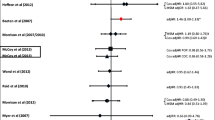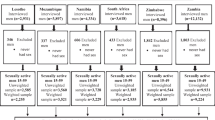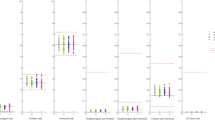Abstract
HIV susceptibility linked to hormonal contraception (HC) has been studied before, but with mixed results. Reports from some of the recent findings have prompted the World Health Organisation to encourage women who use HC to concurrently use condoms in order to prevent HIV infection in the light of possible increased HIV risk of infection associated with hormone-based contraceptives. A two-sex HIV model classifying women into three risk groups consisting of individuals who use condoms, natural methods, and hormone-based contraceptives is formulated and analysed to assess the possible effects of various birth control strategies on the transmission dynamics of the disease. Our model results showed that women who use HC could be key drivers of the epidemic and that their increased infectivity may be critical in driving the epidemic. Women who use hormone-based contraceptives potentially act as a core group from which men get infected and in turn transmit the disease to other population groups. We fitted the model to HIV prevalence data for Zimbabwe reported by UNAIDS and Zimbabwe Ministry of Health and Child Care and used the model fit to project HIV prevalence. Predictions using HIV data for Zimbabwe suggest that a hypothesised increase in susceptibility and infectivity of two-, three-, and fourfold would result in a 25, 50, and 100% increase in baseline HIV prevalence projection, respectively, thus suggesting possible increased disease burden even in countries reporting plausible HIV prevalence declines. Although a possible causal relationship between HIV susceptibility and HC use remains subject of continuing scientific probe, its inclusion as part of birth control strategy has been shown in this study, to possibly increase HIV transmission. If proven, HC use may potentially explain the inordinate spread of HIV within the sub-Saharan Africa region and therefore compel for urgent assessment with a view to reorienting birth control methods in use in settings with generalised epidemics.







Similar content being viewed by others
References
Ahmed S et al (2001) HIV incidence and sexually transmitted disease prevalence associated with condom use: a population study in Rakai, Uganda. AIDS 15:2171–2179
AFP (2011) New birth control method urged for developing world women. http://www.google.com-hostednews-afp-article. Accessed 21 May 2012
Baeten JM, Benki S, Chohan V et al (2007) Hormonal contraceptive use, herpes simplex virus infection, and risk of HIV-1 acquisition among Kenyan women. AIDS 21:1771–1777
Bahamondes L, Trevisan M, Andrade L et al (2000) The effect upon the human vaginal histology of the long-term use of the injectable contraceptive Depo-Provera. Contraception 62:23–27
Bingenheimer JB (2010) Men’s multiple sexual partnerships in 15 sub-Saharan African countries: sociodemographic patterns and implications. Stud Fam Plan 41:1–17
Blower SM, Dowlatabadi H (1994) Sensitivity and uncertainty analysis of complex models of disease transmission: an HIV model as an example. Int Stat Rev 62(2):229–243
Blower SM, Hartel D, Dowlatabadi H, Anderson RM, May RM (1991) Drugs, sex and HIV: a mathematical model for New York City. Philos Trans R Soc Lond 331:171–187
Blower SM, Sanchez MA (1997) Uncertainty and sensitivity analysis of the basic reproductive rate: tuberculosis as an example. Am J Epidemiol 145:1127–1137
Blythe PS, Castillo-Chavez C (1989) Like with like preference and sexual mixing models. Math Biosci 96:221–238
Brauer F (2008) Epidemic models with heterogeneous mixing and treatment. Bull Math Biol 70:1869–1885
Busenserg S, Chavez CC (1991) A general solution of the problem of mixing of subpopulations and its application to risk, and age structured epidemic models of the spread of AIDS. IMA J Math Appl Med Biol 8:1–29
Catholic Church contraception policy. http://dbp.idebate.org-en-index.php-Debate:-Catholic-Church-contraception-policy. Accessed 15 Dec 2012
Contraception-Ancient methods in use today, evolution of the condom. www.scienceclarified.com/Ci-Co/Contraception.html. Accessed 21 June 2012
Creanga AA, Gillespie D, Karklins S, Tsui AO (2011) Low contraceptive use among the poor in Africa: an equity issue. http://www.who.int/bulletin/volumes/89/4/10-083329/en/index.html. Accessed 11 Jan 2013
Cuadros DF, Crowley PH, Augustine B, Stewart SL, Garcáa-Ramos G (2011) Effect of variable transmission rate on the dynamics of HIV in sub-Saharan Africa. BMC Infect Dis 11:216
Del Valle SY, Hyman JM, Hethcote C, Eubank SG (2007) Mixing patterns between age groups in social networks. Soc Netw 29:539–554
Delvaux T, Buvé A (2013) Hormonal contraception and HIV acquisition—what is the evidence? What are the policy and operational implications? Eur J Contracept Reprod 18(1):15–26
Diekmann O, Heesterbeek JAP, Metz JAP (1990) On the definition and computation of the basic reproduction ratio \(R_0\) in models for infectious diseases in heterogeneous populations. J Math Biol 28(4):365–382
Dushoff J, Wenzhang HW, Castillo-Chavez C (1998) Backwards bifurcations and catastrophe in simple models of fatal diseases. J Math Biol 36:227–248
Fan M, Chowa L, Feng Z (2011) Dynamics of a multi-group epidemiological model with group-targeted vaccination strategies. J Theor Biol 291:56–64
Global Envision (2007) The effect of migration on HIV rates. http://www.globalenvision.org/library/9/1758. Accessed 11 Jan 2013
Gregson S, Garnett GP, Shakespeare R, Foster G, Anderson RM (1994) Determinants of the demographic impact of HIV-1 in sub-Saharan Africa: the effect of a shorter mean adult incubation period on trends in orphanhood. Health Transit Rev AIDS Impact Prev Dev World Demogr Soc Sci Perspectives 4:65–92
Gregson S et al (2006) HIV decline associated with behaviour change in eastern Zimbabwe. Science 311:664–666
Gribble J, Haffey J (2008) Reproductive health in Sub-Saharan Africa. Population Reference Bureau
Guardian (2011) HIV could spread if birth control injections increase warn scientists: researchers call for new guidelines for women using family planning in AIDS-hit areas. http://www.guardian.co.uk/world/2011/oct/04/hiv-spread-birth-control-warn-scientists. Accessed 21 May 2012
Haddad LB (2014) Contraceptive methods and risk of HIV acquisition or female to male transmission. Curr HIV/AIDS Rep 11(4):447–458
Hansasuta P, Rowland-Jones SL (2001) The changing face of HIV and AIDS HIV-1 transmission and acute HIV-1 infection. Br Med Bull 58(1):109–127
Heffron R, Donnell D, Rees H et al (2011) Use of hormonal contraceptives and risk of HIV-1 transmission: a prospective cohort study. Lancet Infect Dis 12(1):19–26
Hethcote HW (2000) The mathematics of infectious diseases. SIAM Rev 42(4):599–653
Hethcote HW, Van Ark WJ (1987) Epidemiological models for heterogeneous populations: proportional mixing, parameter estimation and immunisation programs. Math Biosci 84:85–118
Hove-Musekwa SD, Nyabadza F, Mambili-Mamboundou H (2011) Modelling hospitalization, home-based care, and individual withdrawal for people living with HIV/AIDS in high prevalence settings. Bull Math Biol 73(12):2888–2915
Hickson RI, Mercer GN, Lokuge KM (2011) Sensitivity analysis of a model for tubercolosis. In: 19th International congress on modelling and simulation. http://mssanz.org.au/modsim2011. Accessed 01 May 2012
Hyman JM, Li SJ (1997) Disease transmission models with biased partnership selection. Appl Numer Math 24:379–392
Hyman JM, Li J (1997) Behavior changes in SIS STD models with selective mixing. J Appl Math 57(4):1082–1094
IRIN,HIV/AIDS (2012) Hormonal contraception advice not reaching women. http://www.irinnews.org. Accessed 21 May 2012
Jacquez AJ, Simon CP, Koopman J, Arbor A, Sattenspiel L, Perry T (1988) Modeling and analyzing HIV transmission: the effect of contact patterns. Math Biosci 92:119–199
Kapiga SH et al (1998) The incidence of HIV infection among women using family planning methods in Dares Salaam, Tanzania. AIDS 12(1):75–84
Kiddugavu M et al (2003) Hormonal contraceptive use and HIV-1 infection in a population based cohort in Rakai, Uganda. AIDS 17(2):233–240
Kleinschmidt I et al (2007) Injectable progestin contraceptive use and risk of HIV infection in a South African family planning cohort. Contraception 75(6):461–467
Kumwenda JJ, Makanani B, Taulo F et al (2008) Natural history and risk factors associated with early and established HIV type 1 infection among reproductive-age women in Malawi. Clin Infect Dis 46:1913–1920
Lagarde E, Auvert B, Chege J et al (2001) The multicentre study of factors determining the different prevalences of HIV in sub-Saharan Africa, Condom use and its association with HIV/sexually transmitted diseases in four urban communities of sub-Saharan Africa. AIDS 15:S71–S78
Lakshmikantham V, Leela S, Martynyuk AA (1989) Stability analysis of nonlinear systems. Marcel Dekker, Inc., New York and Basel, pp 1–315
Lamptey P, Wigley M, Carr D, Collymore Y (2002) Facing the HIV/AIDS pandemic. Popul Bull 57(3)
LaSalle JP (1976) The stability of dynamical systems. In: CBMS-NSF regional conference series in applied mathematics, vol 25
Lavreys L et al (2004) Hormonal contraception and risk of HIV-1 acquisition: results of a 10-year prospective study. AIDS 18(4):695–697
Malunguza N, Mushayabasa S, Chiyaka C, Mukandavire Z (2010) Modelling the effects of condom use and antiretroviral therapy in controlling HIV/AIDS among heterosexuals, homosexuals and bisexuals. Comput Math Methods Med 11(3):201–222
Malunguza NJ, Hove-Musekwa SD, Musuka G, Mukandavire Z (2012) Investigating alcohol consumption as a risk factor for HIV transmission in heterosexual settings in sub-Saharan African communities. Bull Math Biol 74(9):2094–2124
McKay MD, Conover WJ, Beckman RJ (1979) A comparison of three methods for selecting values of input variables in the analysis of output from a computer code. Technometrics 21:239–245
Marseillea E, Kahnb JG, Billinghurst K, Sabad J (2001) Cost-effectiveness of the female condom in preventing HIV and STDs in commercial sex workers in rural South Africa. Soc Sci Med 52(1):135–148
Marx PA et al (1996) Progesterone implants enhance SIV vaginal transmission and early virus load. Nat Med 2(10):1084–1089
McCoy SI, Zheng W, Montgomery E, Blanchard K, van Der Straten A, de Bruyn G, Padian NS (2012) Oral and injectable contraception use and risk of HIV acquisition among women in the methods for improving reproductive health in Africa (MIRA) study. AIDS 27:1001–1009
Miller L, Patton DL, Meier A et al (2000) Depomedroxyprogesterone-induced hypoestrogenism and changes in vaginal flora and epithelium. J Obstet Gynaecol 96:431–439
Moghadas SM Gumel AB, McLeod RG, Gordon R (2003) Could condoms stop the AIDS epidemic. J Theor Med 5:171–181
Morrison CS, Cates W (2008) Contraception, contraceptive technology, and STDs. In: Holmes K, Stamm W, Wasserheit J, Cohen M (eds) Sexually transmitted diseases, 4th edn. McGraw Hill, New York, pp 1493–1510
Morrison CS, Skoler-Karpoff S, Kwok C, Chen PL, van de Wijgert J, Gehret-Plagianos M, Patel S, Ahmed K, Ramjee G, Friedland B, Lahteenmaki P (2012) Hormonal contraception and the risk of HIV acquisition among women in South Africa. AIDS 26(4):497–504
Morrison CS et al (2010) Hormonal contraception and HIV acquisition: reanalysis using marginal structural modeling. AIDS 24(11):1778–1781
Morrison CS, Skoler-Karpoff S, Kwok C, Chen PL, van de Wijgert J, Gehret-Plagianos M, Patel S, Ahmed K, Ramjee G, Friedland B, Lahteenmaki P (2012) Hormonal contraception and the risk of HIV acquisition among women in South Africa. AIDS 26(4):497–504
Mukandavire Z, Garira W (2006) HIV/AIDS model for assessing the effects of prophylactic sterilizing vaccines, condoms and treatment with amelioration. J Biol Syst 14(3):323–355
Mukandavire Z, Chiyaka C, Magombedze G, Musuka G, Malunguza N (2009) Assessing the effects of homosexuals and bisexuals on the intrinsic dynamics of HIV/AIDS in African heterosexual settings. Math Comput Model 49(9–10):1869–1882
Mukandavire Z, Garira W (2007) Sex-structured HIV/AIDS model to analyse the effects of condom use with application to Zimbabwe. J Math Biol 54(5):669–699
Mukandavire Z, Malunguza NJ, Chiyaka C, Musuka G, Tchuenche JM (2009) HIV/AIDS model assessing the effects of gender-inequality affecting women in African heterosexual settings. Int J Biomath 3(1):43–67
Myer L et al (2007) Prospective study of hormonal contraception and women’s risk of HIV infection in South Africa. Int J Epidemiol 36(1):166–174
Nold A (1980) Heterogeneity in disease-transmission modeling. Math Biosci 5:227–240
Nyabadza F, Mukandavire Z, Hove-Musekwa SD (2011) Modelling the HIV/AIDS epidemic trends in South Africa: insights from a simple mathematical model. Nonlinear Anal Theory Methods Appl 12(4):2091–2104
Okech TC, Wawire NW, Mburu TK (2011) Contraceptive use among women of reproductive age in Kenya’s city slums. Int J Bus Soc Sci 2(1):22–43
Over M, Piot P (1993) HIV infection and sexually transmitted diseases. In: Jamison DT, Mosley WH (eds) Disease control priorities in developing countries. Oxford University Press, New York, pp 455–527
Polis CB, Curtis KM (2013) Use of hormonal contraceptives and HIV acquisition in women: a systematic review of the epidemiological evidence. Lancet Infecti Dis 13(9):797–808
Polis CB, Phillips SJ, Curtis KM (2013) Hormonal contraceptive use and female-to-male HIV transmission: a systematic review of the epidemiologic evidence. AIDS 27(4):493–505
Polis CB et al (2014) Hormonal contraceptive methods and risk of HIV acquisition in women: a systematic review of epidemiological evidence. Contraception 90(4):360–390
Ramjee G, Wand H (2012) Population-level impact of hormonal contraception on incidence of HIV infection and pregnancy in women in Durban, South Africa. Bull World Health Organ 90:748–755
Reid SE et al (2010) Pregnancy, contraceptive use, and HIV acquisition in HPTN 039: relevance for HIV prevention trials among African women. J Acquir Immune Defic Syndr 53(5):606–613
Shanti RC (2012) Sub-Saharan Africa at the turning point-contraceptive use gains acceptance. https://www.thefreelibrary.com/Sub-Saharan+Africa+at+the+turning+point.-a020979794. Accessed 21 May 2012
Singh S, Sedgh G, Hussain R (2010) Unintended pregnancy: worldwide levels, trends, and outcomes. Stud Fam Plan 41(4):241–250
Tanser F, Bärnighausen T, Hund L, Garnett GP, McGrath N, Newell M (2011) Effect of concurrent sexual partnerships on rate of new HIV infections in a high-prevalence, rural South African population: a cohort study. Lancet 378(9787):247–255
Thomas G, Lungu EM (2009) The influence of heavy alcohol consumption on HIV infection and progression. J Biol Syst 17(4):685–712
UNAIDS fact sheets. http://www.unaids.org. Accessed 31 Aug 2012
UNAIDS (1998) Report on the global HIV/AIDS epidemic. http://data.unaids.org. Accessed 25 Jan 2015
UNAIDS (2000) Report on the global HIV/AIDS epidemic. http://data.unaids.org. Accessed 07 Feb 2012
UNAIDS (2001) We can end poverty by 2015. http://www.un.org/millenniumgoals/bkgd.shtml. Accessed 15 Mar 2014
UNAIDS (2005) Evidence for HIV decline in Zimbabwe: a comprehensive review of the epidemiological data. http://data.unaids.org/Publications/IRC-pub06/zimbabwe_epi_report_nov05_en
UNAIDS (2006) Report on the global HIV/AIDS epidemic. Joint United Nations programme on HIV/AIDS. http://www.unaids.org. Accessed 25 Nov 2011
UNAIDS (2008) Report on the global AIDS epidemic. http://www.unaids.org. Accessed 08 Aug 2014
UNGASS (2010) Zimbabwe UNGASS country progress report. http://data.unaids.org/Report/zimbabwe-2008-country-progress. Accessed 31 Aug 2012
UNAIDS (2010) Global report: UNAIDS report on the global AIDS epidemic. http://www.unaids.org. Accessed 24 July 2013
van den Driessche P, Watmough J (2002) Reproduction numbers and sub-threshold endemic equilibria for compartmental models of disease transmission, John A. Jacquez memorial volume. Math Biosci 180(2002):29–48
Wadman M (2012) Contraceptive risk of HIV long suspected. Nature. http://www.nature.com/news/2011/111007/full/news.2011.582.html. Accessed 01 Nov 2012
Wand H, Ramjee G (2012) The effects of injectable hormonal contraceptives on HIV seroconversion and on sexually transmitted infections. AIDS 26(3):375–380
Wang CC, Kreiss JK, Reilly (1999) Risk of HIV infection in oral contraceptive pill users: a meta-analysis. J Acquir Immune Defic Syndr (21):51–58
World Bank (2012) World development indicators. Washington, DC. http://www.workinfo.com/Workforce/20997-devindicators. Accessed 12 Dec 2012
Yeatman SE, Trinitapoli J (2010) Beyond denomination: the relationship between religion and family planning in rural Malawi. PMC 9(55):1851–1882
ZIMDATA (2011) http://www.zimstat.co.zw/index.php?. Accessed 25 Nov 2012
Acknowledgements
NJM and SDH-M acknowledge, with thanks, financial support from the National University of Science and Technology. The authors acknowledge Dr. Christinah Mukandavire for useful comments and discussions on the manuscript.
Author information
Authors and Affiliations
Corresponding author
Appendices
Appendix 1
Substituting the values of \(S^*_{f_c},S^*_{f_n},S^*_{f_h},S^*_{m},I^*_{f_c},I^*_{f_n},I^*_{f_h},I^*_{m}\) into \(\lambda ^*_{f_c},\lambda ^*_{f_n},\lambda ^*_{f_h} ~\hbox {and}~\lambda ^*_{m}\) gives
Using the relationship \(\lambda ^*_{f_c}=\displaystyle \frac{(1-p_{c})\rho _{fm_c}}{\rho _{fm_n}}\lambda ^*_{f_n},\lambda ^*_{f_h}=\displaystyle \frac{\chi \rho _{fm_h}}{\rho _{f_nm}}\lambda ^*_{f_n}~\hbox {and}~\lambda ^*_{f_n}=\frac{c_f\beta _m\lambda ^*_m\rho _{f_nm}}{({{\mathcal {K}}}_1+\lambda ^*_m)}\) and solving for \(\lambda ^*_{m}\) where
and
Further algebraic manipulations result in the following quatic function shown in Eq. (17) whose solution is shown in Eqs. (18), (19), (20), and (21).
Appendix 2
Global stability of endemic equilibrium.
Proof
At equilibrium, the following relations hold
and
Consider the candidate Lyapunov function V, such that
Clearly, \(S_{f_c}-S^*_{f_c}\) is an increasing polynomial and \(S^*_{f_c}\displaystyle \ln {\frac{S_{f_c}}{S^*_{f_c}}}\) is logarithmic function, and using the same argument on the rest of the variables, the polynomial will outgrow the logarithmic function and therefore
What is left is to prove that
The time derivative of V along the solution path is given by
Substituting equilibrium values and rewriting expressions for the derivatives of the state variables, we obtain the following system
Substituting into Eq. (23), the rearranged expressions for the derivatives of the state variables as well as the equilibrium values of \({{\mathcal {K}}}_1I^*_{f_c},{{\mathcal {K}}}_1I^*_{f_n},{{\mathcal {K}}}_1I^*_{f_h}~\hbox {and}~{{\mathcal {K}}}_1I^*_{m}\), we obtain the following expression
Collecting like terms, the derivative reduces to
Substituting equilibrium values in Theorem 4,
Based on the conditions for the validity of the candidate Lyapunov function \(S_{f_c}>S^*_{f_c},S_{f_n}>S^*_{f_n},S_{f_h}>S^*_{f_h},S_{m}>S^*_{m},I_{f_c}>I^*_{f_c}, {\dot{V}}\le 0\). We used the Lyapunov stability theorem to show that \({\dot{V}}<0\) for all
and the strict equality \({\dot{V}}=0\) holds only for \(S_{f_c}=S^*_{f_c},S_{f_n}=S^*_{f_n},S_{f_h}=S^*_{f_h},S_{m}=S^*_{m},I_{f_c}=I^*_{f_c},I_{f_n}=I^*_{f_n},I_{f_h}=I^*_{f_h}~\hbox {and}~I_m=I^*_m\). Then the only equilibrium state \(\xi ^*\) is the only positively invariant set of the endemic solution for model system (5) contained entirely in \({{\mathcal {D}}}\) and hence by the asymptotic stability theorem in LaSalle (1976), the endemic equilibrium state \(\xi ^*\) is a sink. This completes the proof. \(\square \)
Rights and permissions
About this article
Cite this article
Malunguza, N.J., Hove-Musekwa, S.D. & Mukandavire, Z. Assessing the Potential Impact of Hormonal-Based Contraceptives on HIV Transmission Dynamics Among Heterosexuals. Bull Math Biol 79, 738–771 (2017). https://doi.org/10.1007/s11538-017-0252-y
Received:
Accepted:
Published:
Issue Date:
DOI: https://doi.org/10.1007/s11538-017-0252-y




